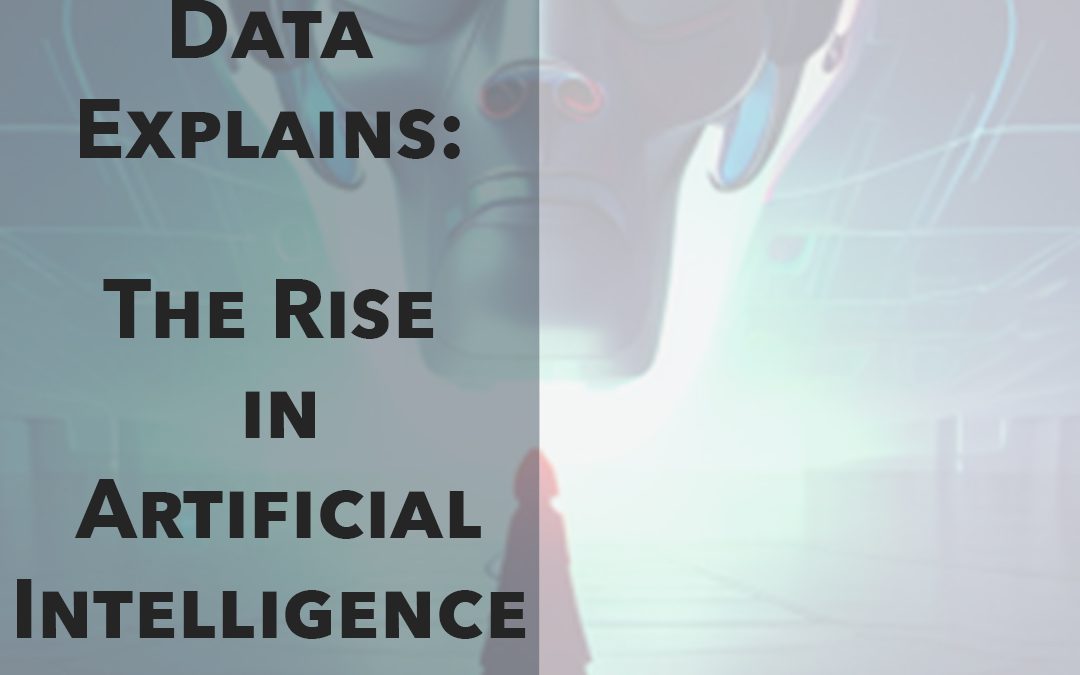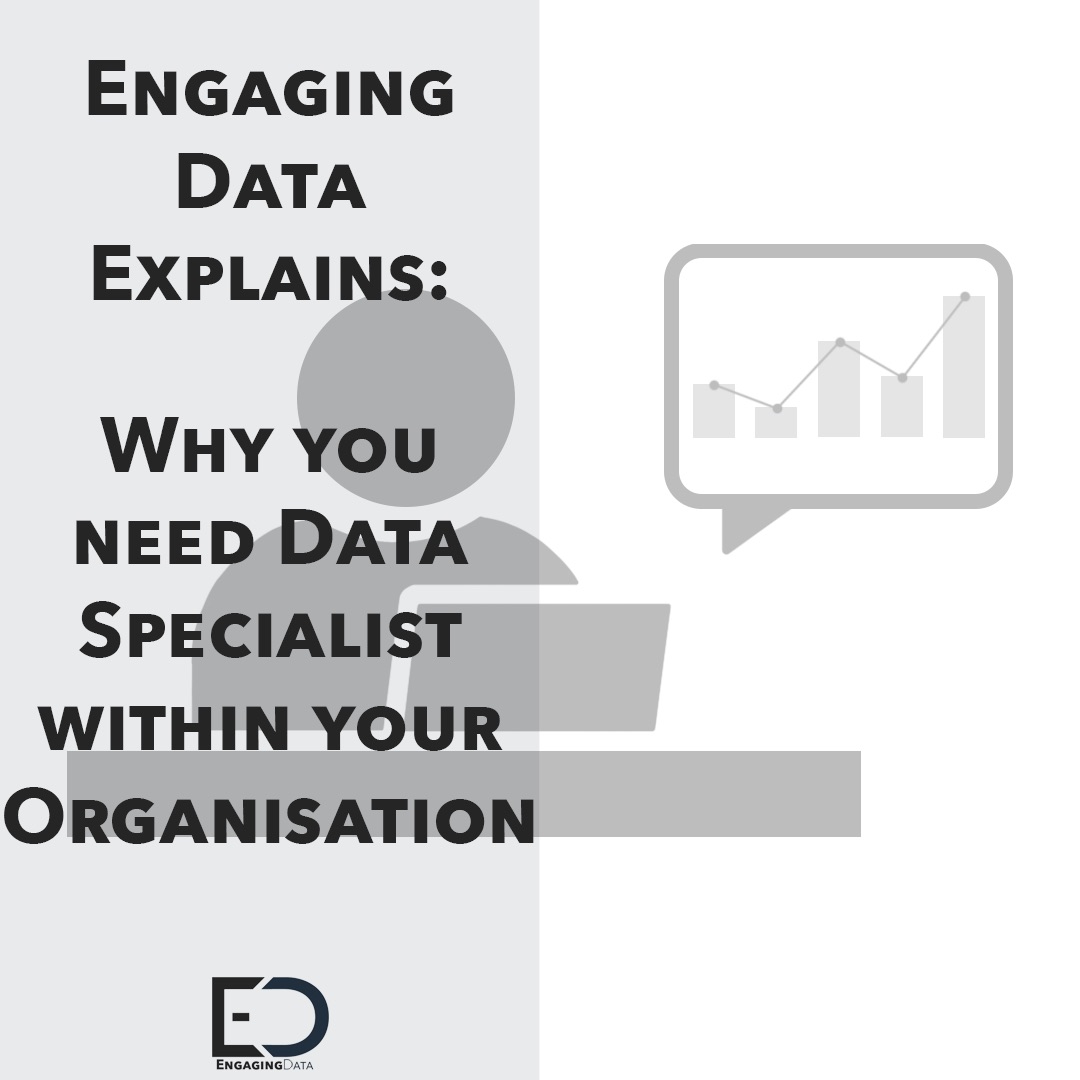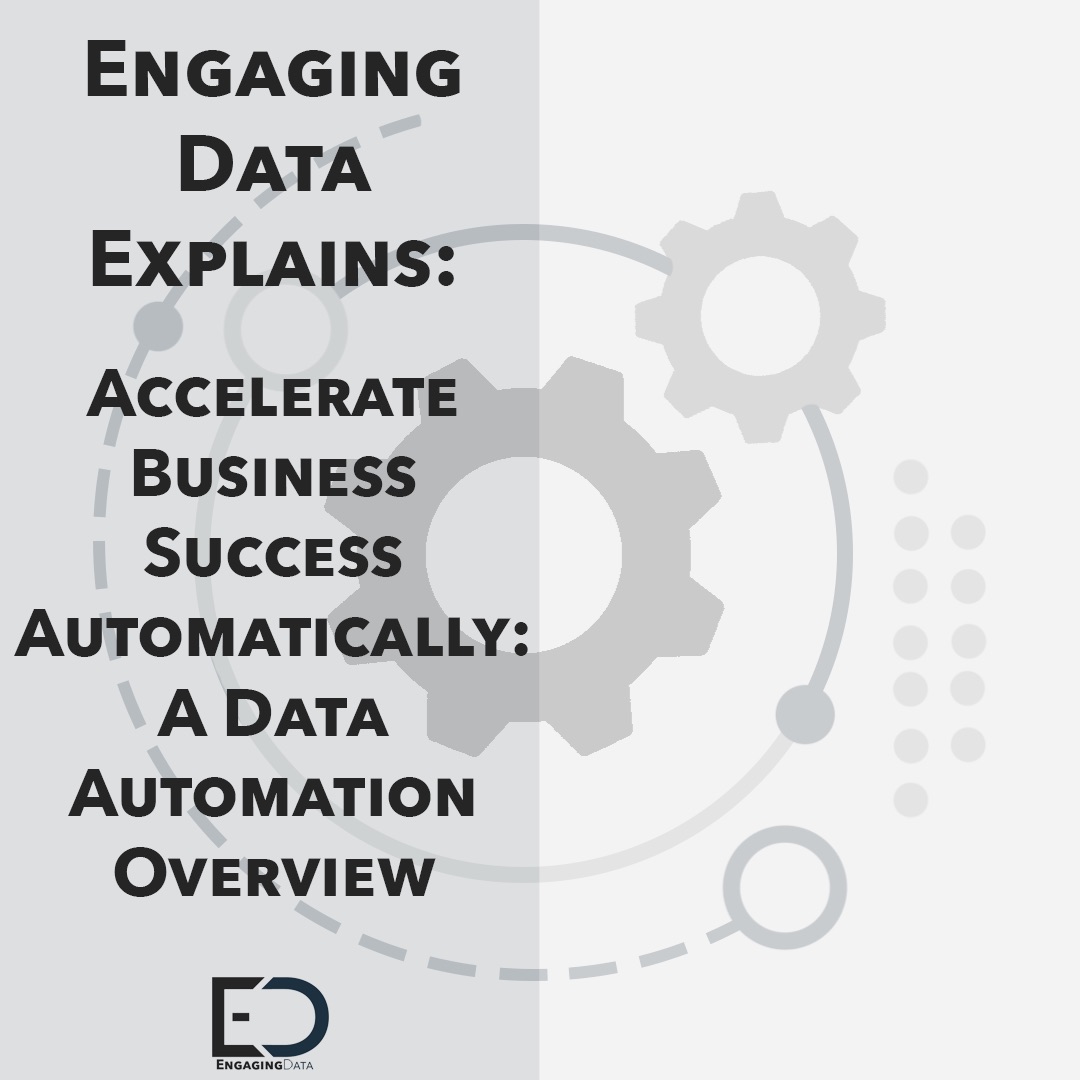
How to Create and Manage a Data Science Team
How to Create and Manage a Data Science Team
Data Science is a relatively new, evolving and exciting data function. As this article explains, different organisations have various ways of organisation their data science teams, along with its managing them.
Organisations increasingly see data as a valuable asset that will help them succeed, now and in the future.
The value of data has been increasing in recent years, and it shows no sign of slowing down.
The first barrier to effective data and analytics is still the lack of qualified talent. Other familiar challenges include limited access to siloed data, lack of processing power and the absence of a data strategy to help turn data into actional information, which we have discussed previously here. More and more organisations are creating data science functions to lead their efforts in data mining, predictive modelling, machine learning and Artificial Intelligence (AI).
We have created this guide to provide best practices for creating and managing a Data Science team.
We have included the different ways a team can be set up, the positions it is likely to form and the executives to whom a team may report.
Models for Structuring a Data Science Team:
Data collection, management and analysis are typically the responsibility of the Chief Information Officer (CIO). The IT team works with business users to implement data warehouses and business intelligence (BI) systems that hold and organise data, enabling fundamental analysis and reporting.
However, over the past two decades, more organisations have separated the data function into their department as internal data stores grew, supporting technologies evolved, and data-related tasks became more differentiated and specialised.
The increasing importance of analytics to business success also drove the need for a data science team with skilled Data Scientists and Engineers. Today, many organisations, anything from a team or an entire data science department, provide this service. Larger organisations may have multiple teams that operate independently or in a coordinated way.
These teams are tasked with collecting and cleaning data from various sources, identifying patterns and insights, and presenting their findings to executives with actionable recommendations. Often this involved working with internal teams, external partners and vendors specialising in certain analysis types.
Data Scientists may work in areas like Sales and Marketing, Finance and Accounting, Product Development, Human Resources, Customer Service, Operation Management, Risk Management, Legal Affairs, Compliance/Governance, etc.
How a company structures its teams vary based on its Data Science program’s maturity, data analytics goals, overall organisational structure and enterprise culture. However, some common Data Science team structure models have emerged, each with pros and cons.
Team structure can be:
A Decentralised Team:
Where members work within the individual business units they support. This allows team members to collaborate closely with businesses on data science projects.
This approach can under the strategic use of data across an organisation and require more resources than smaller companies may have available.
A Centralised Team:
That consolidates a data science function into the enterprise, which manages individual projects and oversees resourcing. This approach allows for an enterprise-wide strategic view and uniform implementation of analytics best practices more efficiently.
However, it can limit the ability of team members to become experts in a particular area of the business. Some organisations establish a formal data science centre as a centralised team.
A Hybrid Team:
This approach creates a data science team who centrally manage all project with specific business operations. This team is accountable for helping those units reach their objectives and make data-driven decisions.
In hybrid structures, a centre of excellence may also focus on promoting best practices and standards for data science. As with the decentralised model, resource constraints can be an issue.
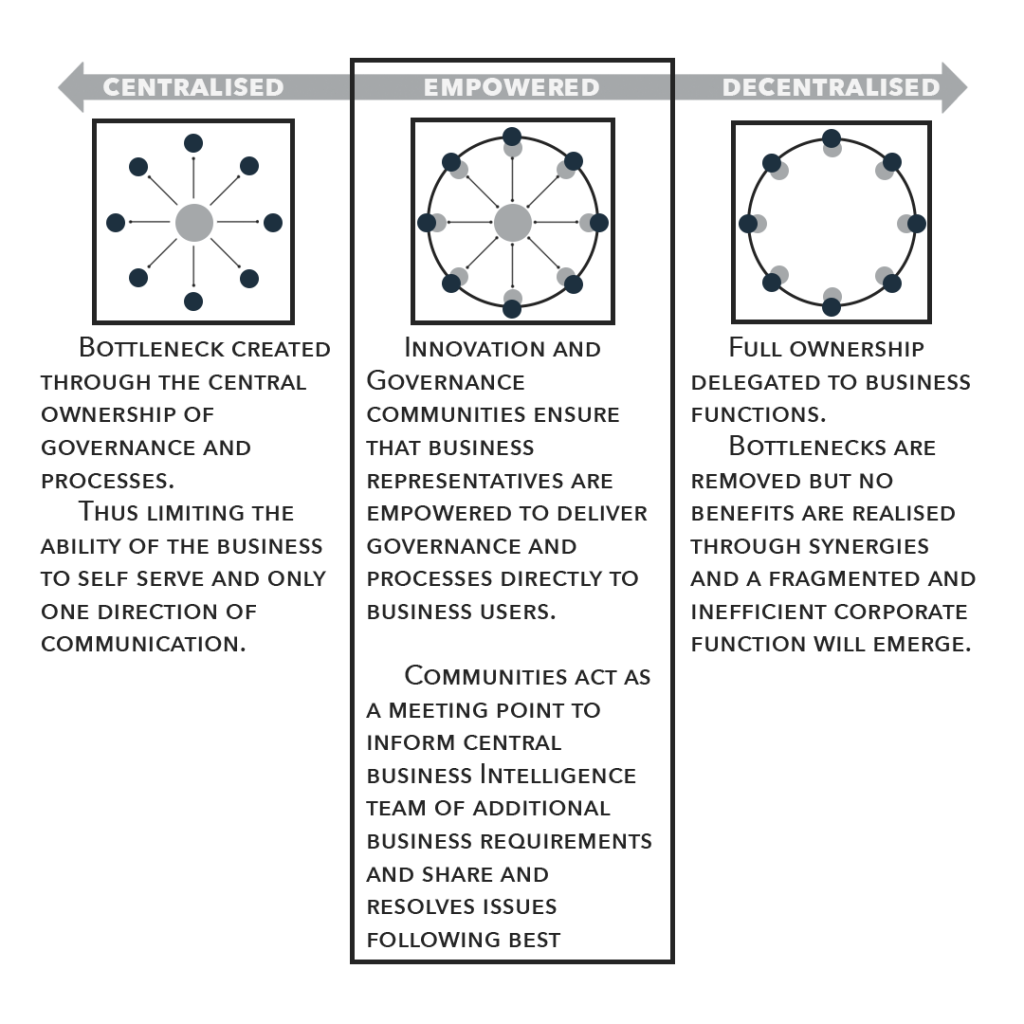
Data Science Team – Roles and Responsibilities:
Successful data science teams share common structures, roles and responsibilities regardless of the size or scale.
Small organisations with limited analytics needs or early-stage data science initiatives may have a generalist handle all the required tasks. Larger entities and those with more mature programs typically include some combination of the following roles in their data science teams:
Data Scientists – Data Scientists are key team members, using statistical methods and machine learning algorithms to analyse data and create predictive models. They also build data products, recommendation engines and other technologies for various use cases.
Data Scientists typically have multiple skills in mathematics, statistics, data wrangling, data mining, coding and predictive modelling. Expect people in this role to have advanced data science degrees or graduate-level data science certifications.
Data Analyst – Data Analysts are responsible for collecting and maintaining data from operational systems and databases. they use statistical methods and analytic tools to interpret the data and prepare dashboards and reports for business users. Data Analysts do not have the complete skillset of a Data Science, but they can support data science efforts.
Data Engineer – This role is responsible for building, testing and maintaining the data pipelines that power a business. A Data Engineer uses software engineering and computer science skills to focus on the technology infrastructure, data collection, management and storage. Data Engineers work closely with Data Scientists on data quality, preparation, model deployment and maintenance tasks.
Data Architect – Data Architects are responsible for designing and overseeing the system design and infrastructure implementation. A Data Engineer can also assume this role.
Machine Learning Engineer – Sometimes, this role is referred to as an AI Engineer: Machine Learning Engineers are responsible for creating, deploying and maintaining the algorithms and models needed for machine learning and AI initiatives.
In some organisations, Data Science teams may also include these positions:
Citizen Data Scientist – An informal role can involve business analysts, business-unit power users and other employees capable of doing their own data analytics work. Citizen Data Scientists are often interested in understanding or training in advanced analytics. However, their technologies – for example, automation machine learning tools – typically require little to no coding. They often work outside a data science team but may be incorporated into ones embedded in business units.
Business Analyst – Business Analysts are key in supporting the work of data scientists. Data Scientists are responsible for tethering, cleaning and organisation data, as well as creating new or altering models that predict what will happen in the future,
In addition, Business Analysts may be attached to Data Science teams, which includes evaluating business processes and translating business requirements into analysis plans, areas in which they can help support the work of data scientists.
Data Translator – The term ‘analytics translator’ is relatively new in the corporate world, but it refers to a very important role growing in popularity. The Analytics Translator acts as a liaison between Data Science teams and Business Operations, helping create and plan projects and translate the insights from data analytics into recommended business actions. This role often falls to the Business Analyst.
Data Visualisation Developer or Engineer – They’re tasked with creating data visualisations to make information more accessible and understandable for business professionals. However, Data Scientists and Analysts may handle this role in some teams.
Regardless of sector or industry, Data Science teams need to be strong in three core areas: Mathematical, Technology and Business Acumen,. It is rare to find a single person that excels in all three. Often companies will have someone fluent in two of the three, and then the rest of the team is built around that, filling in the caps to ensure the team is strong in all three.
Simon Meacher, Managing Director, EngagingData
Management and Oversight –
A Data Science team will be managed and overseen by either a lead Data Scientist, Data Science Manager, Director of Data Science or a similar managerial position.
The reporting structure for teams similarly varies. Generally, organisations assign a C-Level executive or high-ranking functional manager to oversee the Data Science team.
A Chief Data Officer (CDO) often oversees the Data Science function.
In 2002, Captial One created the first CDO position within the Financial Services industry. Since then, the CDO role has grown in popularity.
This role initially focused on Data Governance, Management and Security functions. More recently, CDOs have also taken on responsibility for Data Science, Analytics and AI.
Other organisations have created a Chief Analytics Officer (CAO) role to oversee their Data Science and Analytic teams.
Hybrid roles exist, combining the CDO and CAO responsibilities into a Chief Data and Analytics Officer role.
The head of a Data Science team may be subject to matrix reporting, allowing the role to report to a different Executive; for example, the COO, CFO or CIO or a position such as Director of Analytics, Business Intelligence Director, Head of Business Data or Director of Data and Strategy.
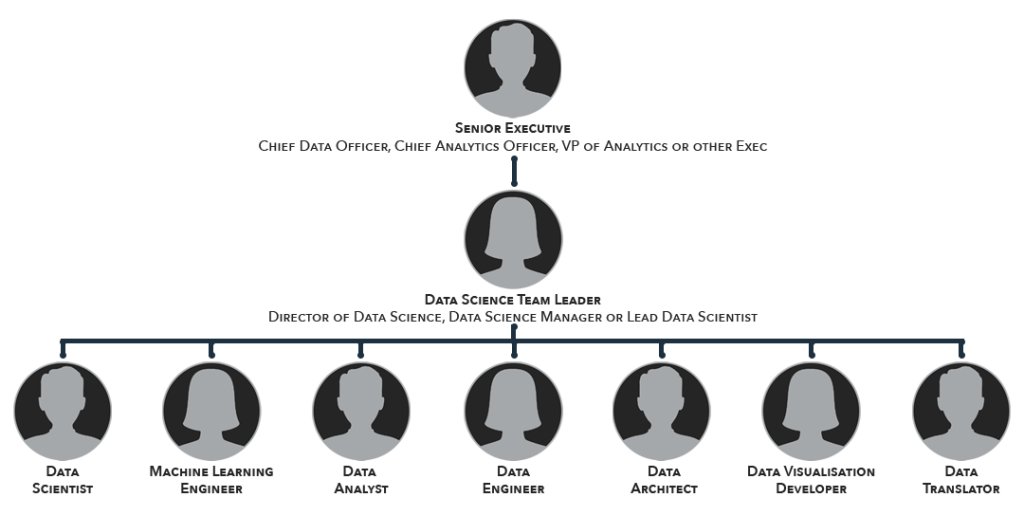
How Data Scientists work with Business Users –
Organisations within all industries are recognising the need to become data-driven and see it as a key to remaining competitive and set up the Data Science team to collaborate with business teams to:
– Understand the business problem or questions that the team want to answer
– Set and articulate the objectives for using the data.
– Plan how to apply the knowledge to make decisions and take action.
Once they understand Data Science teams cannot merely present their findings. They work with the business teams to understand the insights gained from the data and how that information can shape product and service offerings, marketing campaigns, supply chain management and other critical parts of business processes and operations to support company goals., such as: higher revenue, increased efficiency and better customer service.
In my experience, Data Science teams need to work closely with the business. Without using the wealth of knowledge about the data from the business, the Data Scientists will struggle to provide value from the data.
Carl Richards, Head of Consulting, EngagingData
Tools that a Data Science Team Needs –
Dozens of tools, ranging from data visualisation and reporting software to advanced analytics, machine learning and AI technologies, enable Data Science teams’ work. The number and combinations of technologies needed can be unique to each team based on its goals and skill levels.
The following is a list of commonly used Data science tools that include bothering commercial and open-source technologies:
– Statistical Analysis Tools: SAS and IBM SPSS
– Machine Learning frameworks and libraries: TensorFlow, Weka, Scikit-Learn, Keras and PyTorch
– Data Science platforms from various vendors that provide diverse sets of capabilities for analytics, automated machine learning and workflow management and collaboration programming languages: Python, R, Julia, SQL, Scala and Java
– Jupyter Notebook and other interactive notebook applications for sharing documents that contain code, equations, comments and related information
– Data Visualisation tools: Tableau, QlikView, Power Bi, D3.JS, Matplotlib
– Analytics Engines and Big Data Platforms: AWS, Azure, Google BigQuery, Hadoop, Snowflake, Spark
– Cloud Object Storage Services and NoSQL Databases
– The Kubernetes container orchestration service for deploying analytics and machine learning workloads in the cloud.
Best Practices for Managing a Data Science Team –
Executives and team leaders seeing to build and mature their Data Science programs should consider the following best practices for managing their teams.
Seek out workers with a range of business, interpersonal, and technical skills to help ensure that the team can meet organisational objectives.
Create a culture of learning and innovation that challenges team members and encourages them to bring new thinking to business problems and issues.
Promote analytics projects that encourage close collaboration between the Data Science team and the business units they support.
Evaluate team members at least partly on the business successes and work drives. Create a mentorship program to help advance the skills of junior team members, and do ongoing training to ensure that all workers stay current on key data techniques and technologies.
Talent retention programmes will help keep Data Scientists, who are in high demand and experienced, with plenty of job opportunities.
Overall, the world is changing, and Data Science is one of the most powerful tools for that change.
Data Science is more than just crunching numbers; creating a greater data science function within your company will benefit your organisation and future-proof its ability to change with its strategic objectives.
By embracing Data Science as an integral part of your business, you can ensure that your organisation is agile enough to keep up with technological changes and consumer behaviour.
Do you need help creating or managing your Data Science Team? Do you want to create a data-driven culture within your organisation? Or do you need to use Data Science Professionals?
Fill out the form below, and one of our team will be in touch to discuss your requirements further.

